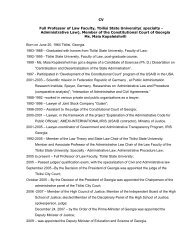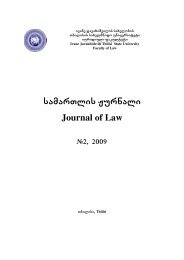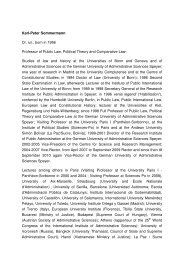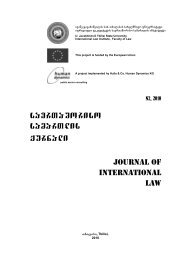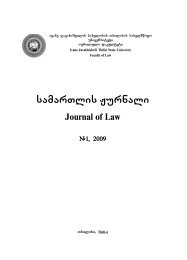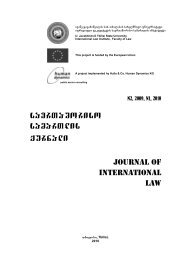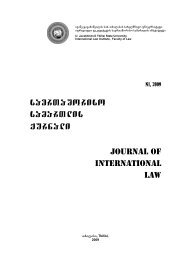Untitled
Untitled
Untitled
Create successful ePaper yourself
Turn your PDF publications into a flip-book with our unique Google optimized e-Paper software.
saerTaSoriso samarTlis Jurnali, #1, 2008 JOURNAL OF INTERNATIONAL LAW, N1, 2008<br />
respect it and it must, in particular, ensure that<br />
the Convention is complied with by its different<br />
authorities. The fact that the medical institutions<br />
were not judicial in character is immaterial<br />
in this respect. In any event, the examination<br />
in question was to be effected in<br />
the context of judicial proceedings supervised<br />
by the court, which remained responsible for<br />
ensuring the speedy conduct of the trial”. 59<br />
Deriving from this, it is clear that:<br />
First, upon the ratification of a convention<br />
a state undertakes responsibility to implement<br />
it and is responsible for all the violations within<br />
its jurisdiction, notwithstanding whether this<br />
is caused by a court or other state institutions.<br />
A party to the European Convention on Human<br />
Rights is a State and not its separate institutions,<br />
for example, a court. The state institutions<br />
and officials undertake the public<br />
authority and respectively, a State is responsible<br />
for their actions.<br />
Second, the deliberation can go even further.<br />
A state shall fulfill both – negative and<br />
positive obligations. It must not only not violate<br />
the conventional provisions itself, but must<br />
secure to any person within its jurisdiction the<br />
rights protected by the Convention.<br />
In the case Martins Moreira v. Portugal in<br />
which the Court found the State liable for violations<br />
exercised by the medical institution,<br />
considered that the medical institution came<br />
under the administrative authority of the Ministry<br />
of Justice. Accordingly, the Portuguese<br />
State was under a duty to provide them with<br />
appropriate means in relation to the objectives<br />
pursued so as to enable them to comply with<br />
the requirements of Article 6 para. 1. 60<br />
We consider that notwithstanding whether<br />
this medical institute would be a state or a<br />
private establishment, a state responsibility<br />
should have been involved in any case.<br />
A state shall protect its own national not<br />
only from violating the rights by the state bodies,<br />
but also in those cases, when the legal<br />
interests of the former are violated by other<br />
private or legal persons.<br />
Respectively, if a right of a person to an<br />
expedite proceeding is violated, it is surplus<br />
to deliberate on who contributed to this – a<br />
civil servant or a private individual. A state shall<br />
not allow violation of human rights and in case<br />
if this takes place any way, it shall react over<br />
it. In the contrary situation it shall be held responsible,<br />
as first it could not protect a person<br />
from violating the rights and afterwards it<br />
did not provide for recovering the rights violated.<br />
Third, judicial authorities are rightly<br />
charged with a special role in the expeditious<br />
administration of justice. A court is not only<br />
obliged to observe the terms established for<br />
certain procedural obligations itself, but also<br />
to provide for efficient and expeditious holding<br />
of the proceedings. It must undertake the<br />
measures in respect of each of the participants<br />
of the proceedings in order not to give<br />
anyone a possibility to interfere with the swift<br />
administration of justice.<br />
In the case Vernillo v. France the European<br />
Court concluded, that “the national courts<br />
are obliged to create such conditions to states,<br />
which would provide to avoid the unjustifiable<br />
prolongation of the consideration of a case“. 61<br />
“The courts are responsible for ensuring<br />
that cases proceeded satisfactorily in cooperation<br />
with the parties”. 62<br />
One of the most interesting issues within<br />
the measures undertaken by a court is the<br />
unification of cases, which frequently has become<br />
an issue of contention.<br />
For instance, in the case Kemmache v.<br />
France the Court held that the case of the<br />
applicant was unified with the case of Mr.<br />
Klaushofer. His return to France was belatedly<br />
provided by the Swiss state bodies. This<br />
caused the delaying the proceedings for two<br />
years and eight months. The applicant alleged<br />
that if the return of Mr. Klaushofer was impossible,<br />
the State bodies could have separated<br />
proceedings in respect with Mr. Kemmache<br />
and Mr. Ceccio, what did not happen as the<br />
accused were risking very harsh sentence and<br />
Mr. Klaushofer’s statement was one of the<br />
important elements. The European Court did<br />
not accept the argument of the Government,<br />
as to the impossibility of the separation of such<br />
cases. Therefore, the Court found violation of<br />
Article 6(1). 63<br />
Different decision was made in the case<br />
Boddaert v. Belgium. The Court noted that the<br />
applicant and Mr. Piron were charged with the<br />
murder of Jehin. Mr. Piron was also accused<br />
in committing other crimes. One of the crimes<br />
was closely linked with the murder of Jehin.<br />
The investigating judge chose to shelve the<br />
investigation in case and to await the outcome<br />
of the investigation of the “second case” in<br />
order to complete the file of the first and to<br />
122





